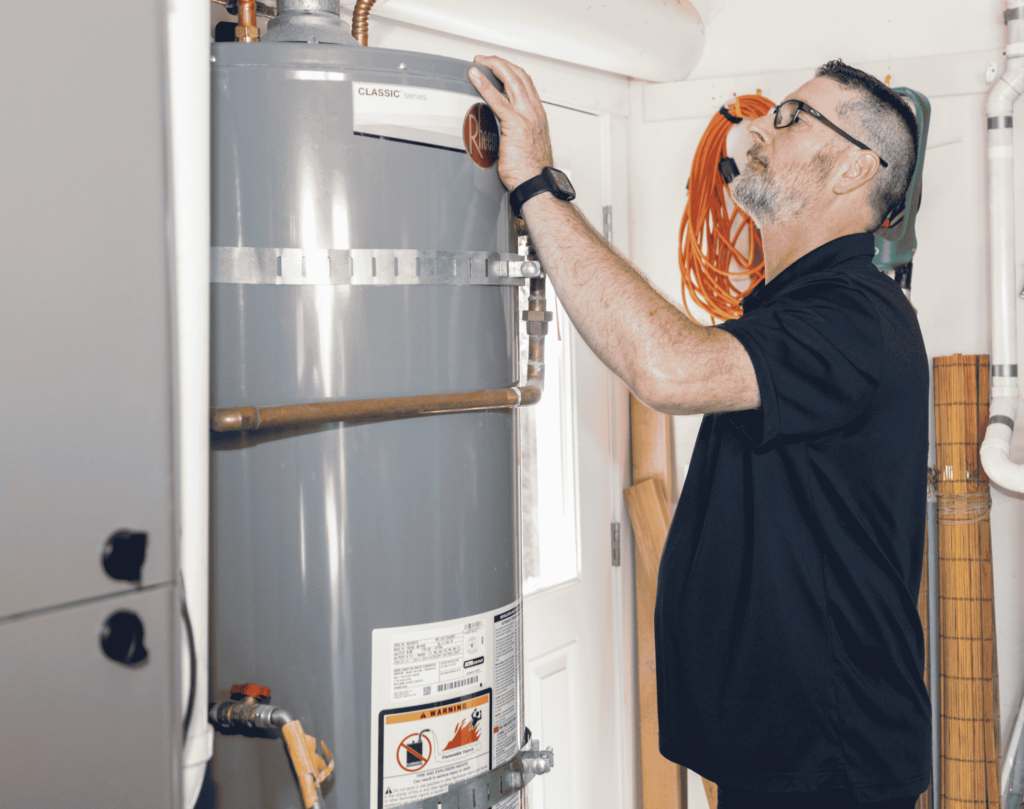Maintaining your water heater is essential for ensuring reliable hot water, improving energy efficiency, and extending the lifespan of your system. Over time, sediment buildup can reduce efficiency, cause damage, and lead to costly repairs. One of the best ways to prevent these issues is by regularly flushing your water heater.
In this guide, we’ll cover the process of flushing a water heater, the benefits of regular maintenance, and when to schedule professional water heater services.
What Does Flushing a Water Heater Involve?
Flushing your water heater removes accumulated sediment that can settle at the bottom of the tank. The process involves the following steps:
- Turn Off the Heater: If you have an electric water heater, switch off the power. If it’s gas-powered, turn off the gas supply.
- Connect a Hose: Attach a hose to the drain valve, directing the other end to a safe drainage area.
- Drain the Tank: Open the drain valve and allow the water to flow, flushing out sediment.
- Refill and Restart: Close the drain valve, refill the tank with fresh water, and restore power or gas supply.
While homeowners can flush their water heaters themselves, professionals use specialized equipment to thoroughly and safely clean your system.
Why Is It Important to Flush Your Water Heater Regularly?
Flushing your water heater offers several benefits, including:
- Removes Sediment: Eliminates mineral buildup that can reduce efficiency and damage the tank.
- Improves Efficiency: A clean tank heats water more quickly, reducing energy consumption.
- Extends Lifespan: Prevents wear and tear, helping your water heater last longer.
- Maintains Water Quality: Prevents rust, contaminants, and sediment from entering your water supply.
Regular maintenance keeps your system running smoothly and prevents costly repairs or replacements.
How Often Should You Flush Your Water Heater?
The frequency of flushing depends on several factors:
- Annual Flushing: Most households should flush their water heater once a year.
- High Usage Homes: If you have a large family or use a lot of hot water, flushing may be needed every six months.
- Hard Water Areas: Homes with hard water should flush more frequently to prevent excessive mineral buildup.
- After Repairs or Maintenance: Flushing confirms your system is clean and operating correctly.
If you’re unsure about the proper schedule for your home, a professional can assess your system and provide expert recommendations.
Signs Your Water Heater Needs to Be Flushed
Ignoring sediment buildup can lead to noticeable issues. Here are some signs that it’s time to flush your water heater:
- Discolored Water: Rusty or cloudy water indicates sediment contamination.
- Reduced Hot Water Supply: Buildup can take up space in the tank, reducing the amount of available hot water.
- Strange Noises: Popping or rumbling sounds suggest sediment is moving around inside the tank.
- Higher Energy Bills: A less efficient system consumes more energy, increasing utility costs.
If you notice any warning signs, it’s best to schedule professional maintenance as soon as possible.
Consequences of Not Flushing Your Water Heater
Failing to flush your water heater can lead to significant problems:
- Reduced Efficiency: Sediment buildup forces the system to work harder, raising energy bills.
- Damage to the Tank: Accumulated minerals can corrode the tank, leading to leaks or complete system failure.
- Poor Water Quality: Contaminants and rust can affect the safety and taste of your water.
- Shortened Lifespan: Without regular maintenance, your water heater may fail prematurely, requiring costly replacement.
Preventing these issues is simple with routine flushing and water heater maintenance.
How Sediment Buildup Affects Water Heater Performance
When sediment accumulates in your water heater, it affects performance in multiple ways:
- Insulates the Heating Element: A layer of sediment makes it harder for the heating element to warm the water efficiently.
- Causes Overheating: Trapped heat can overwork components, leading to potential damage.
- Blocks Water Flow: Sediment buildup can clog valves and pipes, reducing hot water pressure and supply.
Addressing these issues early through regular flushing helps maintain optimal performance and prevents system breakdowns.
DIY vs. Professional Water Heater Flushing
While flushing your water heater yourself is possible, there are pros and cons to consider.
DIY Flushing:
- Cost-effective and manageable for those comfortable with home maintenance.
- Requires time and effort to follow proper procedures.
- Risk of improper draining, which could damage the system.
Professional Flushing:
- Uses specialized equipment for a thorough cleaning.
- Guarantees safety and proper handling of all components.
- Identifies potential issues early, preventing costly repairs.
For a thorough and hassle-free experience, consider professional water heater services to confirm your system is maintained correctly and efficiently.
Can Flushing Your Water Heater Save on Energy Bills?
Yes, flushing your water heater can lead to noticeable energy savings. Here’s how:
- A clean tank heats water faster, reducing energy consumption.
- Removing sediment prevents overheating and unnecessary strain on the system.
- Regular maintenance can lower energy costs by up to 10-15%.
By keeping your system efficient, you’ll enjoy reliable hot water while saving money on utility bills.
Conclusion
Regularly flushing your water heater is a simple yet essential maintenance task that improves efficiency, extends lifespan, and ensures high water quality. Whether you handle it yourself or hire a professional, keeping up with routine maintenance can prevent costly repairs and unexpected breakdowns.
Contact Black Hills today for expert water heater services and keep your system running efficiently!

